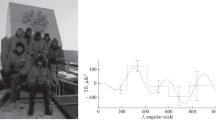Abstract
The idea that the universe is filled with the thermal radiation now termed the Cosmic Microwave Background was discussed in eleven publications in the year 1948. These papers offer a detailed example of the process of development of a new and now very productive line of research, and of the confusion that can attend new ideas. The confusion in this case left a common misunderstanding of the considerations that motivated the idea of the sea of radiation.
Similar content being viewed by others
References
Alpher, R.A. 1948a. On the Origin and Relative Abundance of the Elements. Doctoral dissertation, The George Washington University
Alpher, R.A. 1948b. A Neutron-Capture Theory of the Formation and Relative Abundance of the Elements. Physical Review 74: 1577-1589
Alpher, R.A. and R.C. Herman. 1948a. Evolution of the Universe. Nature 162: 774-775
Alpher, R.A. and R.C. Herman. 1948b. On the Relative Abundance of the Elements. Physical Review 74: 1737-1742
Alpher, R.A., H. Bethe and G. Gamow. 1948. The Origin of Chemical Elements. Physical Review 73: 803-804
Alpher, R.A., R.C. Herman and G.A. Gamow. 1948. Thermonuclear Reactions in the Expanding Universe. Physical Review 74: 1198-1199
Alpher, R.A. and R.C. Herman. 1949. Remarks on the Evolution of the Expanding Universe. Physical Review 75: 1089-1095
Alpher, R.A., R.C. Herman and G.A. Gamow. 1949. On the Origin of the Elements. Physical Review 75: 332
Alpher, R.A. and R.C. Herman. 1950. Theory of the Origin and Relative Abundance Distribution of the Elements. Reviews of Modern Physics 22: 153-212
Alpher, R.A., J.W. Follin and R.C. Herman. 1953. Physical Conditions in the Initial Stages of the Expanding Universe. Physical Review 92: 1347-1361
Alpher, R.A. and R.C. Herman. 1988. Reflections on early work on ‘big bang’ cosmology. Physics Today 41: 24-34
Alpher, R.A. and R.C. Herman. 2001. Genesis of the Big Bang. Oxford University Press, Oxford, p. 214
Bethe, H.A. 1947. Elementary Nuclear Theory. Wiley and Sons, New York
Bondi, H. and T. Gold. 1948. The Steady-State Theory of the Expanding Universe. Monthly Notices of the Royal Astronomical Society 108: 252-270
Chandrasekhar, S. and L.R. Henrich. 1942. An Attempt to Interpret the Relative Abundances of the Elements and Their Isotopes. Astrophysical Journal 95: 288-298
Dicke, R.H., R. Beringer, R.L. Kyhl and A.B. Vane. 1946. Atmospheric Absorption Measurements with a Microwave Radiometer. Physical Review 70: 340-348
Gamow, G. 1937. Structure of atomic nuclei and nuclear transformations. The Clarendon Press, Oxford, p. 270
Gamow, G. 1946a. Expanding Universe and the Origin of Elements. Physical Review 70: 572-573
Gamow, G. 1946b. Rotating Universe? Nature 158: 549
Gamow, G. 1948a. The Origin of Elements and the Separation of Galaxies. Physical Review 74: 505-506
Gamow, G. 1948b. The Evolution of the Universe. Nature 162: 680-682
Gamow, G. 1949. On Relativistic Cosmogony. Reviews of Modern Physics 21: 367-373
Gamow, G. 1952. The creation of the universe. Viking Press, New York, p. 147
Gamow, G. 1954. On the steady-state theory of the universe. Astronomical Journal 59: 200
Gamow, G. and E. Teller. 1939. On the Origin of Great Nebulae. Physical Review 55: 654-657
Gamow, G. and C.L. Critchfield. 1949. Theory of Atomic Nucleus and Nuclear Energy-Sources, Clarendon Press, Oxford, p. 344
Hayashi, C. 1950. Proton-Neutron Concentration Ratio in the Expanding Universe at the Stages preceding the Formation of the Elements. Progress of Theoretical Physics 5: 224-235
Hoyle, F. 1946. The chemical composition of the stars. Monthly Notices of the Royal Astronomical Society 106: 255-259
Hoyle, F. 1948. A New Model for the Expanding Universe. Monthly Notices of the Royal Astronomical Society 108: 372-382
Hoyle, F. 1949. Stellar Evolution and the Expanding Universe. Nature 163: 196-198
Hoyle, F. 1950. Nuclear Energy. The Observatory 70: 194-195
Hoyle, F. and R.J. Tayler. 1964. The Mystery of the Cosmic Helium Abundance. Nature 203: 1108-1110
Hughes, D.J. 1946a. Radiative Capture Cross Sections for Fast Neutrons. Physical Review 70: 106-107
Hughes, D.J. 1946b. Manhattan District Declassified Document, MDDS-27, April 29, 1946
Kragh, H. 1996. Cosmology and Controversy. Princeton University Press, Princeton, NJ, p. 500
Lifshitz, E. 1946. On the Gravitational Stability of the Expanding Universe. Journal of Physics of the USSR 10: 116-129
Mather, J.C. 2007. Nobel Lecture: From the Big Bang to the Nobel Prize and beyond. Reviews of Modern Physics 79: 1331-1348
McKellar, A. 1941. Molecular lines from the lowest states of diatomic molecules composed of atoms probably present in interstellar space. Publications of the Dominion Astrophysical Observatory Victoria 7: 251-272
Osterbrock, D.E. and J.B. Rogerson Jr. 1961. The Helium and Heavy-Element Content of Gaseous-Nebulae and the Sun. Publications of the Astronomical Society of the Pacific 73: 129-134
Peebles, P.J.E. 2013. Dark Matter. arXiv:1305.6859
Peebles, P.J.E., L.A. Page Jr. and R.B. Partridge. 2009. Finding the Big Bang. Cambridge University Press, Cambridge, UK, p. 571
Planck Collaboration XIV. 2013. Cosmological Parameters. arXiv:1303.5076
Schwarzschild, M. 1946. On the Helium Content of the Sun. Astrophysical Journal 104: 203-207
Smoot, G.F. 2007. Nobel Lecture: Cosmic microwave background radiation anisotropies: Their discovery and utilization. Reviews of Modern Physics 79: 1349-1379
Tolman, R.C. 1931. On the Problem of the Entropy of the Universe as a Whole. Physical Review 37: 1639-1660
Tolman, R.C. 1934. Relativity, Thermodynamics, and Cosmology, Clarendon Press, Oxford, p. 497
Author information
Authors and Affiliations
Corresponding author
Rights and permissions
About this article
Cite this article
Peebles, P. Discovery of the hot Big Bang: What happened in 1948. EPJ H 39, 205–223 (2014). https://doi.org/10.1140/epjh/e2014-50002-y
Received:
Revised:
Published:
Issue Date:
DOI: https://doi.org/10.1140/epjh/e2014-50002-y




